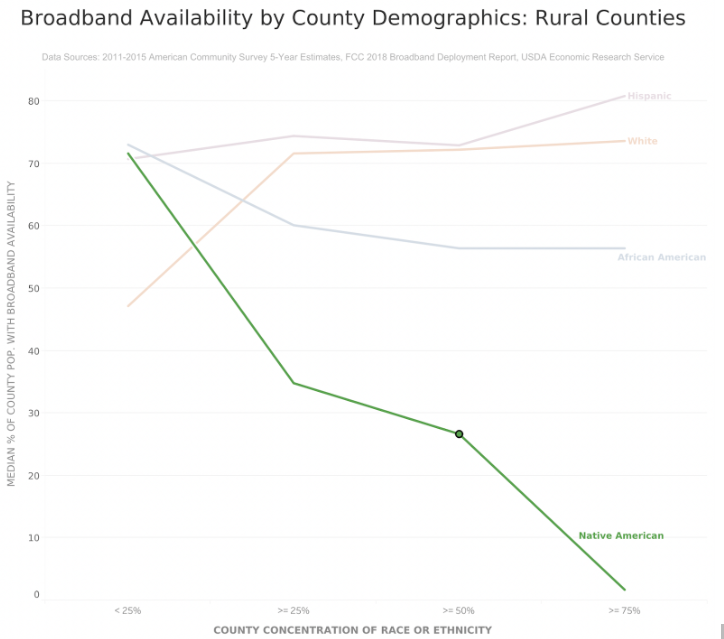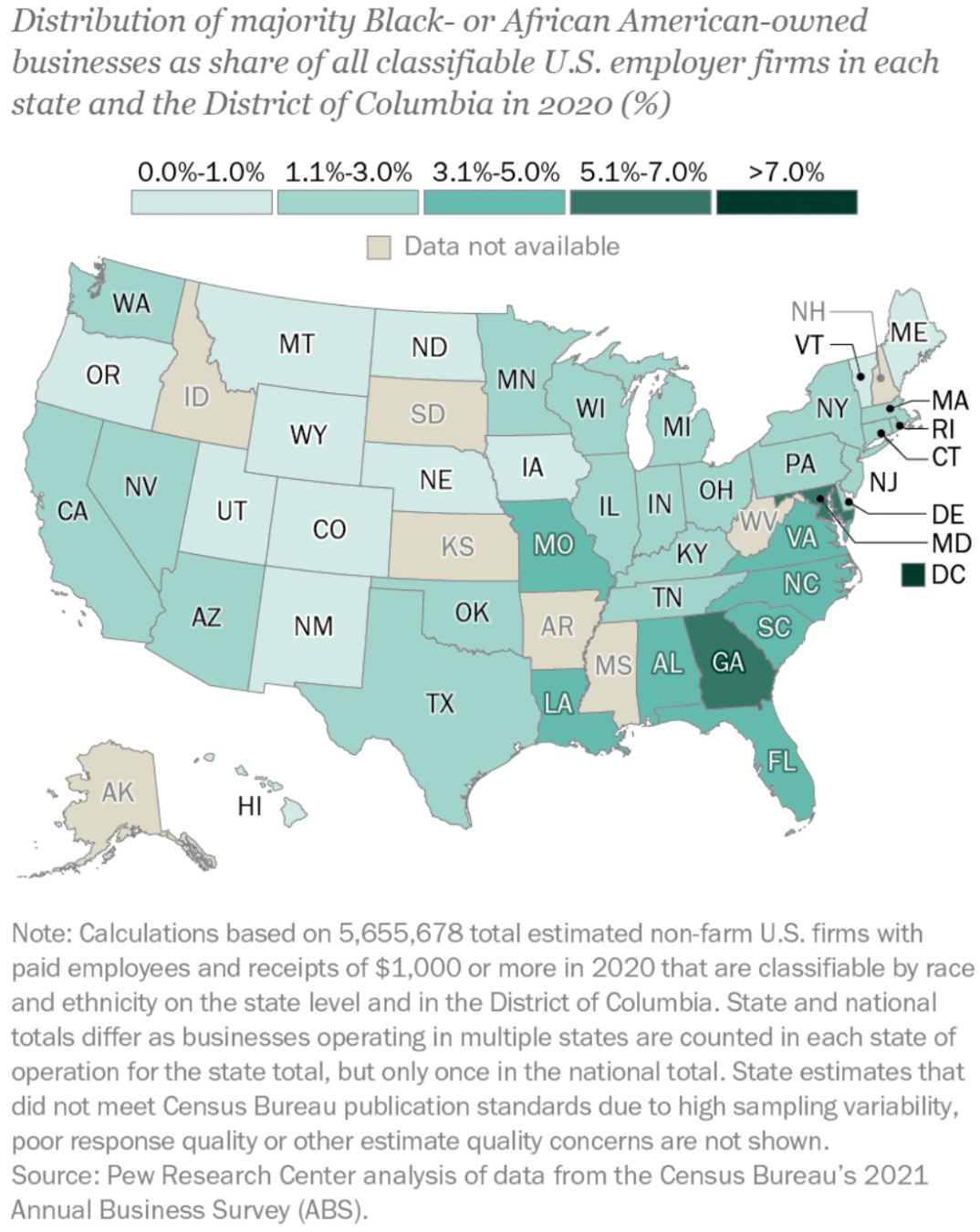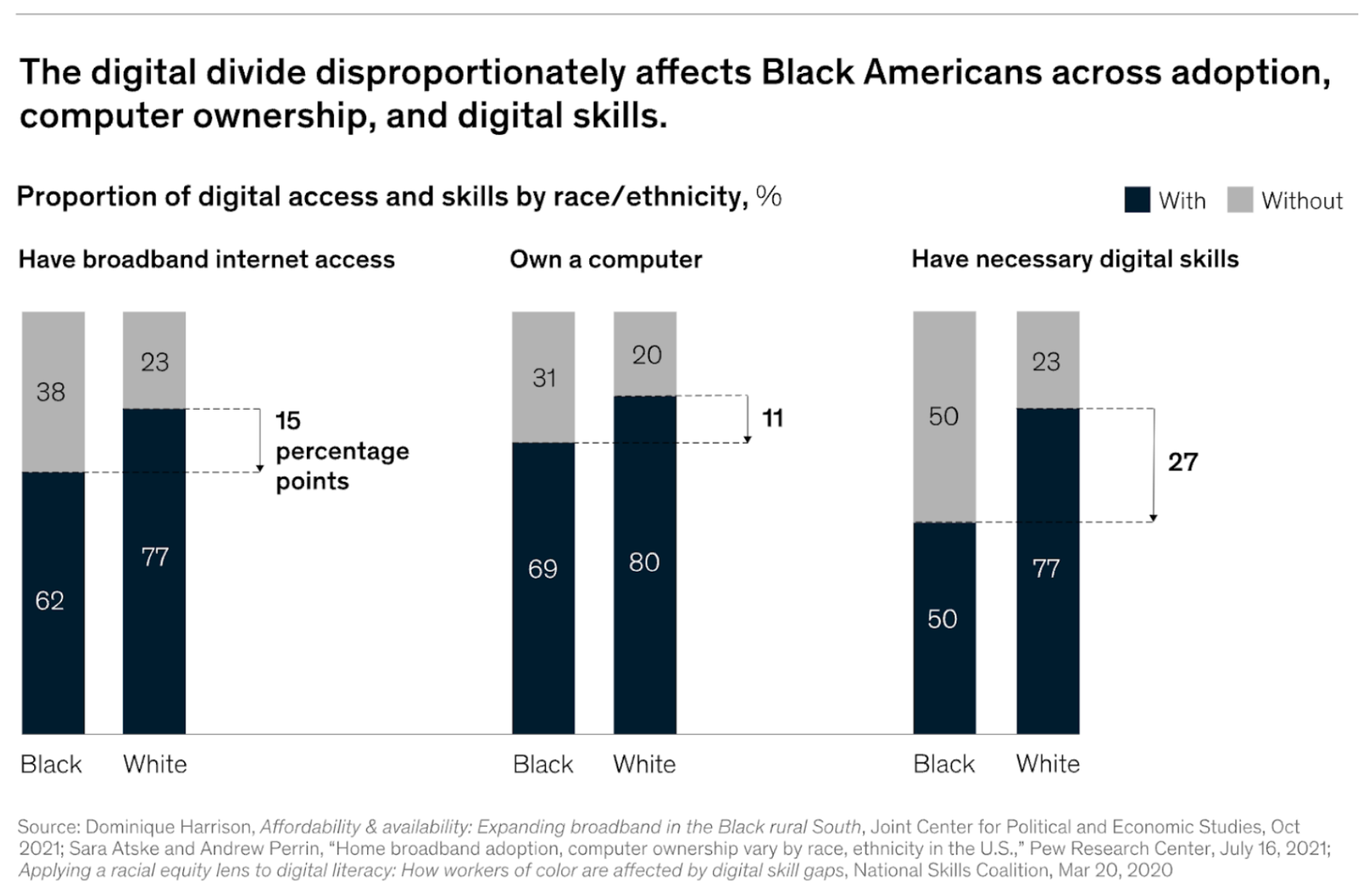Investing in America’s Economic Health Through Broadband Equity
By: Cecilia Marrinan
Broadband inequality has an increasingly deleterious effect on American economic growth. Nineteen million Americans – six percent of this country’s population – lack access to broadband (FCC).
Who is Most Impacted?
Lack of broadband infrastructure or inability to afford an established service primarily impacts rural communities (Lee et al.). This is more prevalent in the rural south and disproportionately affects African American and Indigenous-American households (Harrison). Broadband internet “deserts” are at least partially attributed to digital redlining – the intentional lack of broadband investment in marginalized or rural communities, resulting in network blockades.

Why Access is Vital for Black-owned Businesses
The COVID-19 pandemic has increased reliance on internet access as companies have transitioned to virtual work environments. (De' et al.). This work model exposed the internet’s geographic limitations and created a heightened sense of urgency among legislators to construct technology infrastructures for disconnected Americans (De' et al.).
During the pandemic, 41% of Black-owned businesses floundered in April 2020 compared to 17% of white-owned businesses (Fairlie). Though the pandemic’s long-term impacts on businesses continue to be studied, these initial effects exemplify the limited resources to survive in an e-commerce environment. Post-pandemic, shifting away from the reliance on internet access, Black entrepreneurship rebounded. The number of new Black business owners has risen by 38% (Forbes). This resiliency demonstrates that, without broadband access, systemic barriers would continue should another pandemic necessitate virtual commerce again.

A Call to Action
The Biden Administration prioritized addressing the digital divide through the 2021 Infrastructure Investment Bill and American Jobs Act (IIJA). The 2021 IIJA dedicated $65 billion in federal funds to invest in and expand broadband access (Lee et al.). On March 9th, 2023, President Biden released his 2024 budget, which will allocate $400 million to The Department of Agriculture’s Broadband ReConnect program (USDA). This program – already boosted by the $2 billion in funding from IIJA – aims to empower states to reallocate funding to cover construction costs in rural areas where 90% of households lack broadband service (USDA). Extending broadband service is an admirable proposal, but it does not fully resolve the problem.
Though IIJA is an exemplary bipartisan effort and the 2024 fiscal budget concentrates on rural communities through the ReConnect program, these policies must be used as a springboard to fully achieve broadband equity. The most vulnerable citizens in marginalized communities must be targeted with specific frameworks lest they fall through the inevitable internet “desert” cracks.

With the rapid expansion of artificial intelligence and other emerging technologies, rural Black-owned businesses will continue to be at a competitive disadvantage without adequate broadband access. This may be accomplished through state legislation aimed at abolishing digital redlining and specifically allocating federal funds for research addressing systemic barriers to the internet (Harrison).
Investment in broadband access, particularly in marginalized communities, will grow the American economy by reallocating resources to the fastest-growing entrepreneurial demographic.
References
“Biden Proposes Additional $400 Million to USDA Broadband Reconnect Program.” Global Business Leaders Mag, 13 Mar. 2023, globalbusinessleadersmag.com/biden-proposes-additional-400-million-to-usda-broadband-reconnect-program/.
“Black Women Are the Fastest Growing Group of Entrepreneurs. But the Job Isn't Easy.” J.P. Morgan Wealth Management, www.jpmorgan.com/wealth-management/wealth-partners/insights/black-women-are-the-fastest-growing-group-of-entrepreneurs-but-the-job-isnt-easy.
“Breaking Barriers: Why Black Entrepreneurship Is on the Rise.” Forbes, Forbes Magazine, 31 Mar. 2023, www.forbes.com/sites/forbeseq/2023/03/30/breaking-barriers-why-black-entrepreneurship-is-on-the-rise/?sh=389829542826.
Buck, Xavier. “Investing in Broadband to End Digital Redlining.” Payne Center, paynecenter.org/internet-equity/.
Campisi, Natalie. “Millions of Americans Are Still Missing out on Broadband Access and Leaving Money on the Table-Here's Why.” Forbes, Forbes Magazine, 28 Oct. 2022, www.forbes.com/advisor/personal-finance/millions-lack-broadband-access/#:~:text=Currently%2C%20some%2042%20million%20Americans,of%20at%20least%203%20Mbps.
De', et al. “Impact of Digital Surge during Covid-19 Pandemic: A Viewpoint on Research and Practice.” International Journal of Information Management, U.S. National Library of Medicine, 9 June 2020, www.ncbi.nlm.nih.gov/pmc/articles/PMC7280123/.
“Eighth Broadband Progress Report.” Federal Communications Commission, www.fcc.gov/reports-research/reports/broadband-progress-reports/eighth-broadband-progress-report.
Fairlie, Robert. “The Impact of Covid-19 on Small Business Owners: The First Three Months after Social-Distancing Restrictions.” National Bureau of Economic Research, vol. 29, no. 4, July 2020, pp. 727–740., doi:10.3386/w27462.
Harrison, Dr. Dominique. “Affordability & Availability: Expanding Broadband in the Black Rural South.” Joint Center, 6 Oct. 2021, jointcenter.org/affordability-availability-expanding-broadband-in-the-black-rural-south/.
Lee, et al. “Why the Federal Government Needs to Step up Efforts to Close the Rural Broadband Divide.” Brookings, Brookings, 5 Oct. 2022, www.brookings.edu/research/why-the-federal-government-needs-to-step-up-their-efforts-to-close-the-rural-broadband-divide/#:~:text=As%20even%20the%20FCC%20has,more%20than%20one%20broadband%20option.
Leppert, Rebecca. “A Look at Black-Owned Businesses in the U.S.” Pew Research Center, Pew Research Center, 21 Feb. 2023, www.pewresearch.org/short-reads/2023/02/21/a-look-at-black-owned-businesses-in-the-u-s/.
“Reconnect Loan and Grant Program.” U.S. Department of Agriculture , www.usda.gov/reconnect.
Scavette, Adam. “The End of the Digital Divide? The Future of Broadband Post-Infrastructure Investment and Jobs Act (IIJA).” Federal Reserve Bank of Richmond, 3 Mar. 2022, www.richmondfed.org/research/regional_economy/regional_matters/2022/rm_03_03_2022_broadband.
White, Howard. “Digital Divide: Are Black-Owned Businesses Ready?” Www.180link.Com, 23 Mar. 2023, www.180link.com/strategy/the-unseen-digital-divide-how-covid-19-exacerbated-the-gap-for-minority-owned-businesses/.
Images
Darko, Ayebea, et al. “Closing the Digital Divide in Black America.” McKinsey & Company, McKinsey & Company, 18 Jan. 2023, www.mckinsey.com/industries/public-and-social-sector/our-insights/closing-the-digital-divide-in-black-america.
Pereira, Ivan. “Rural Communities' Digital Deserts Cripple Tele-Education during Coronavirus Outbreak.” ABC News, ABC News Network, 24 Mar. 2020, abcnews.go.com/Technology/rural-communities-digital-deserts-cripple-tele-education-coronavirus/story?id=69618843.
“The Racial Equality and Economic Opportunity Case for Expanding Broadband – Third Way.” – Third Way, 1 Feb. 2019, www.thirdway.org/report/the-racial-equality-and-economic-opportunity-case-for-expanding-broadband.



